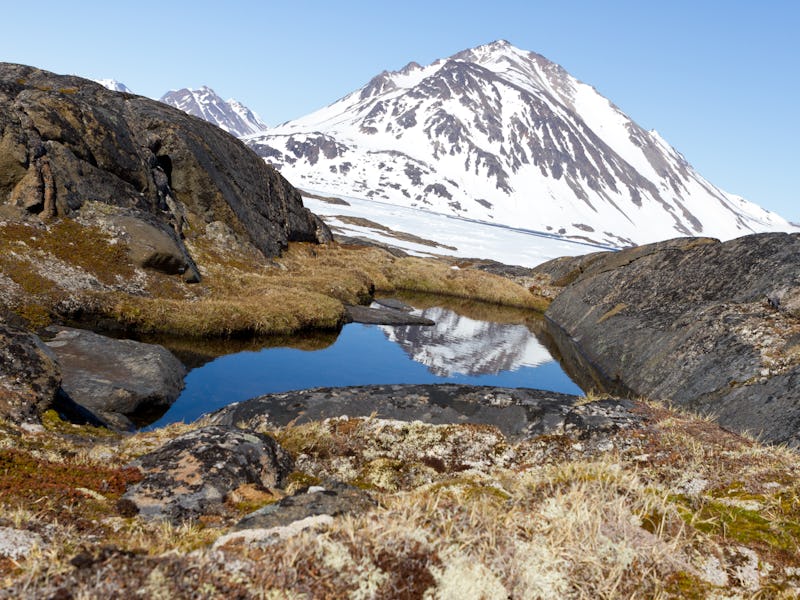Greenland’s Ice Sheet is Both Younger And Less Stable Than Scientists Thought
If the ice sheet melted once, it could easily melt again.

About 80 percent of Greenland is armored in a continuous sheet of ice, three times the area of Texas. But it hasn’t always been that way. At various points in Earth’s past, much of the island was, in fact, actually green — covered in soil and vegetation. The last period of thaw may have been more recent than previously thought, according to new research. The new data comes with worrying implications for present-day climate change and sea level rise.
Tiny organic fossils found deep under the ice in central Greenland show that the middle of the landmass was ice free, serving as habitat for growing plants and insects within the last 1 to 2 million years, per a study published August 5 in the journal Proceedings of the National Academy of Sciences. The exact age of Greenland’s ice sheet remains unresolved, but the ballpark suggested by the new findings bolster the formerly controversial “fragile Greenland” hypothesis, which suggested that the island’s ice sheet has melted at least once since it first formed. And if it thawed entirely before, then it could easily do so again under human-caused global warming, spurring even more dramatic sea level rise than current climate models indicate.
The Pleistocene era lasted from about 2.6 million years ago to the start of the Holocene, 11,700 years ago. During this period, our planet went through several freeze and thaw cycles where glaciers expanded during ice ages and contracted during interglacials. Previously, glaciologists and the research record have disagreed about what was happening on Greenland, during this epoch. For example, one 2016 study of mineral deposits in ocean sediments indicated that the ice sheet has persisted for 7.5 million years. In contrast, another study published that same year assessing isotopes in ice cores suggested that the ice sheet is just 1.1 million years old, with more than 280,000 years of ice-free conditions leading up to its last freeze.
The new research supports that latter finding. The study scientists re-evaluated sediments collected in a two-mile-deep ice core more than 30 years ago from Summit Camp, Greenland, a research station positioned near the very center of the ice sheet. Isotope analysis of quartz extracted from the sand at the bottom of the core suggests that it was buried under ice no more than 2 million years ago.
Isotope analysis of quartz extracted from the sand at the bottom of the core suggests that it was buried under ice no more than 2 million years ago.
Inside the previously frozen sediment, the researchers also identified miniature fossils of a bygone ecological age. Among other bits of remarkably well-preserved biological matter, the scientists found a poppy seed, moss remnants, insect parts, willow wood, and fungi — hallmarks of a tundra landscape. These fossil finds suggest that not only was the center of Greenland ice-free within the past 2 million years, but that it was also unfrozen long enough for soil and a complex ecosystem to form — likely for thousands and thousands of years. “Poppies don’t grow on top of miles of ice,” said Hailey Mastro, co-lead study author and a master’s student researching paleoclimatology at the University of Vermont, in the news statement.
The assemblage of organisms suggests Greenland’s climate was not much warmer than today’s at the time of this last melt, with summer temperatures between 1 and 10 degrees Celsius. Though an ice-free Greenland might be good news for cold-adapted flowers, it’s not good news for us. “This new study confirms and extends that a lot of sea-level rise occurred at a time when causes of warming were not especially extreme,” said Richard Alley, a geoscientist at Penn State who reviewed the research, in a press release. It’s “a warning of what damages we might cause if we continue to warm the climate,” he added. Past assessment of the same 1993 ice core determined that, if the center of Greenland was melted, then 90 percent of the island would also be ice-free.
Already, the Greenland ice sheet is the largest single contributor to ongoing sea level rise, and that melt is accelerating. If the landmass were to lose all of its ice, it would raise global sea level by an alarming 24 feet. Even with current warming, that’s not set to happen right away. Likely it would take hundreds to thousands of years for the island to lose all of its ice mass. But still, less ice on Greenland means much, much less land above water elsewhere.